Post-Tension Tendon Repair & Replacement
Vector Construction is hard at work advancing the state-of-the-art evaluation, repair and protection of post-tensioned structures. Post-tensioned concrete is a unique structural system that is widely used to construct many types of structures such as bridges, parking structures, buildings and tanks. Our engineers and technicians have specialized knowledge and training in the deterioration and repair of post-tensioned concrete.
Click here to download the 2019 Post-Tension Structures: Solutions for Repair & Protection.
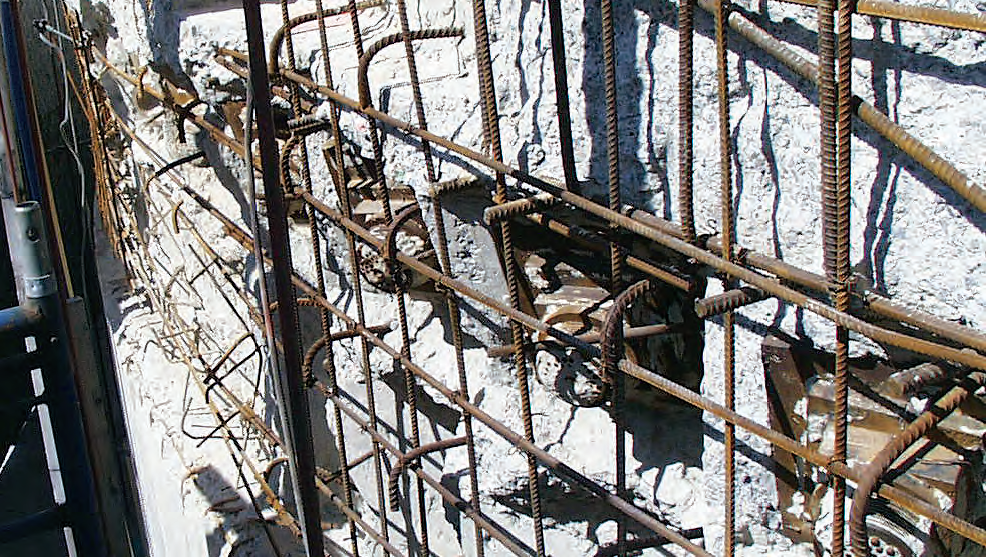
Above: Post-tensioned nuclear containment building required concrete repairs and FRP strengthening.
Special Considerations for Post-Tensioned Structures
Early commercially available unbonded systems were susceptible to corrosion including paper wrapped, plastic push-through (stuffed) and heat-sealed (cigarette wrapped) sheathing systems due to their susceptibility to the ingress of water. Grouted (bonded) post-tensioning systems have also experienced problems due to voids, water bleeding, and grouting problems.
Many investigation and repair techniques utilized for conventionally reinforced concrete are inappropriate for post-tensioned concrete. For example, special techniques are necessary to evaluate corrosion in encapsulated systems where corrosion can occur inside sheathed cables without exposure to external chlorides (as is typical for conventional reinforced concrete). Post-tensioned steel is also more susceptible to damage from chloride-induced pitting corrosion, hydrogen embrittlement, and stress corrosion cracking.
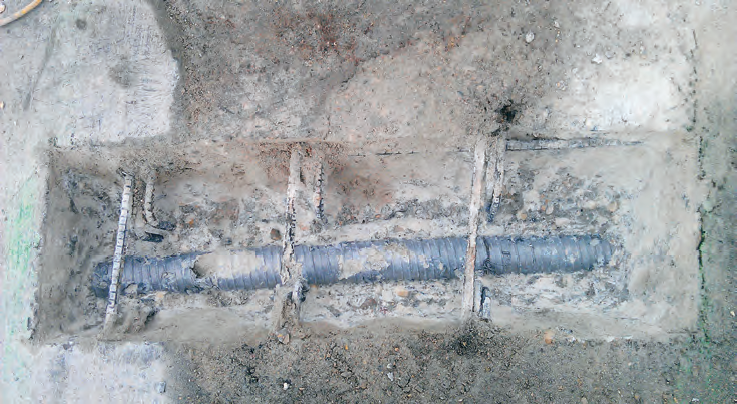
Above: Inspection of grouted (bonded) post-tensioned tendon.
Unbonded Post-Tensioning
Corrosion in unbonded post-tensioning systems can occur anywhere along the length of the tendon but typically occurs at low points where water can accumulate, at uncoated anchors, and at locations where less concrete cover is present. Because the tendon is not in direct contact with concrete or grout, it is not protected by the alkalinity of these materials. As such, if post-tensioned steel is exposed to oxygen and moisture, corrosion can occur even in a chloride-free environment.
In some cases, components of the post-tensioning system such as uncoated anchor plates or exposed strands in front of or behind the anchors are not protected before being embedded directly in concrete. Environmental exposure to chloride or deteriorated grout pockets can cause localized corrosion.
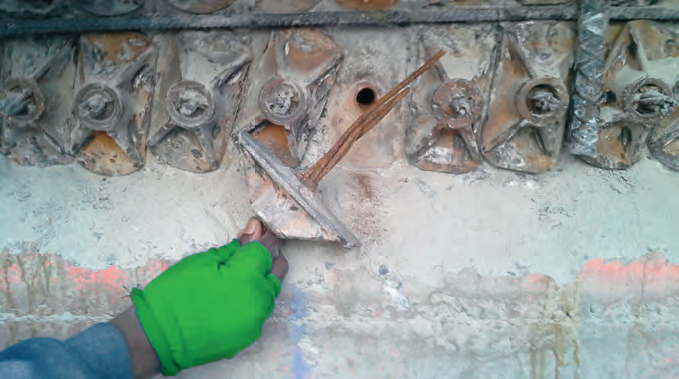
Above: Corrosion of post-tensioned strand adjacent to an anchor plate.
Grouted Post-Tensioning
Bleed water, segregation of portland cement grout and improper grout installation can leave voids and residual moisture in many grouted structures. Formulated, prepackaged grout has been an important advancement in materials technology; however, segregation, pockets of soft grout and chloride contamination have resulted in tendon corrosion.
Visual Inspection
A visual inspection of the surface of a post-tensioned structure can be performed to detect signs of distress. The following defects may be a symptom of a larger problem and merit more substantial investigation.
- Concrete spalling
- Delaminated concrete
- Cracking patterns
- Efflorescence
- Rust staining
- Excessive deflection
- Tendon eruption from the structure
- Evidence of previous repairs or structure modifications such as cored holes for utilities
Tendon Inspection
To gain a greater understanding of the condition of the post-tensioning system, selective semi-destructive testing in representative areas should be completed by experienced personnel. This may include:
- Excavations for inspecting the condition of grease, grout and post-tensioned strands.
- Grout pocket excavation
- Penetration testing
- Chemical testing for corrosive substances
- Post-Tech® PT Corrosion Evaluation (internal moisture)
- In-situ tendon tension
- Strand extraction
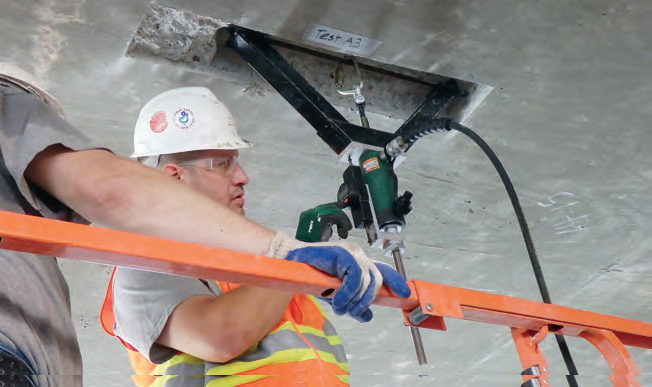
Above: In-situ tension testing. Below: Repair of post-tensioned concrete.
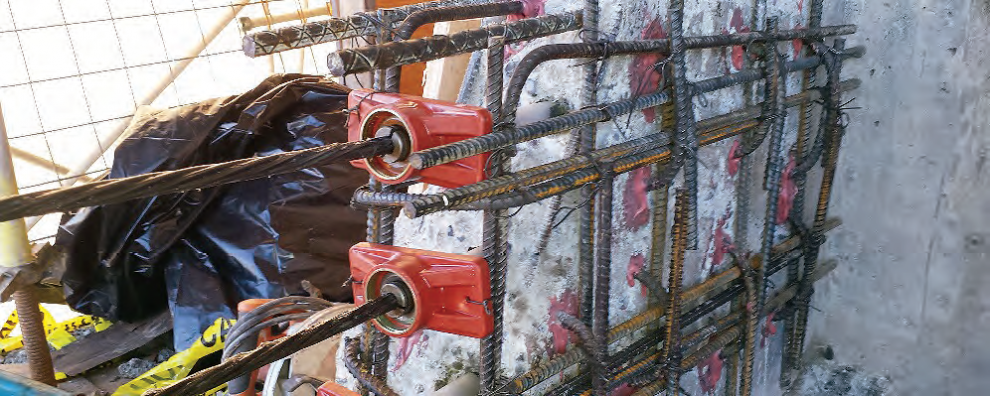
Post-Tensioning Repair
Concrete repair services for post-tensioned structures require a contractor with special knowledge and experience. Our post-tensioning repair services include:
- Shoring
- Tendon splicing
- Strand replacement
- Concrete repair
- Epoxy and urethane injection
- Grouting and sealing cracks
- Joint sealants
- Expansion joint repair
- Void grouting
Structural Strengthening
Post-tensioned structures that have been compromised by corrosion, tendon failure, structural modifications or change of use may benefit from the installation of supplemental strengthening. We have substantial experience in the selection and installation of all strengthening techniques.
- Externally-bonded FRP composites
- Near surface mounted FRP composites
- Steel plate bonding
- Structural enlargement
- External post-tensioning
Corrosion Protection
If post-tensioned structures are subject to corrosion, there are many options that will economically extend their useful service life. We are widely known as a leader in corrosion control technologies.
- Post-Tech® PT Cable Drying
- Post-Tech® PT Grease Injection
- Post-Tech® PTI Impregnation System
- Galvanic protection for uncoated anchorages and post-tensioning steel
- Cathodic protection for the overall structure
- Sealers, coatings and membranes
Click here for more information about Vector's PT Corrosion Mitigation products and services.
Monitoring & Instrumentation
At risk post-tensioned structures can be monitored for changes in structural performance. We assist clients in the selection and installation of instrumentation to collect specific performance data.
- Load and deflection
- Corrosion potentials and corrosion rate
- Tendon and cable moisture
- Acoustic monitoring
- Periodic site inspections
Concrete Preservation Alliance
With significant expertise in investigation, repair and protection of post-tensioned concrete, we deliver practical and long-lasting solutions for posttensioned structures.
Our employees are actively involved in important industry associations such as the Post-tensioning Institute (PTI), International Concrete Repair Institute (ICRI), American Concrete Institute (ACI), American Segmental Bridge Institute (ASBI), American Association of State Highway and Transportation Officials (AASHTO), and the National Association of Corrosion Engineers (NACE). We believe that it is important to support, develop, and educate the post-tension repair industry by promoting best practices through presentation of papers and participation on key technical committees.
We invest heavily in employee training and many of our engineers have received relevant industry certifications such as ASBI Certified Grouting Technician, PTI Level 1 Unbonded Field Installation, PTI Level 2 Unbonded PT Inspector, PTI Bonded PT Field Specialist and NACE Cathodic Protection Specialist (CP4).
Highly stressed post-tensioned steel presents unique risks for injury and property damage due to its stored energy that can be released if it is not handled with care. We have developed specialized equipment and implemented post-tension specific training for employees involved in the investigation and repair of post-tensioned structures. Additionally, Vector participates in Safe Start training, ISNetworld, and COR certification.
We look forward to working with you to solve your post-tensioning problems.



